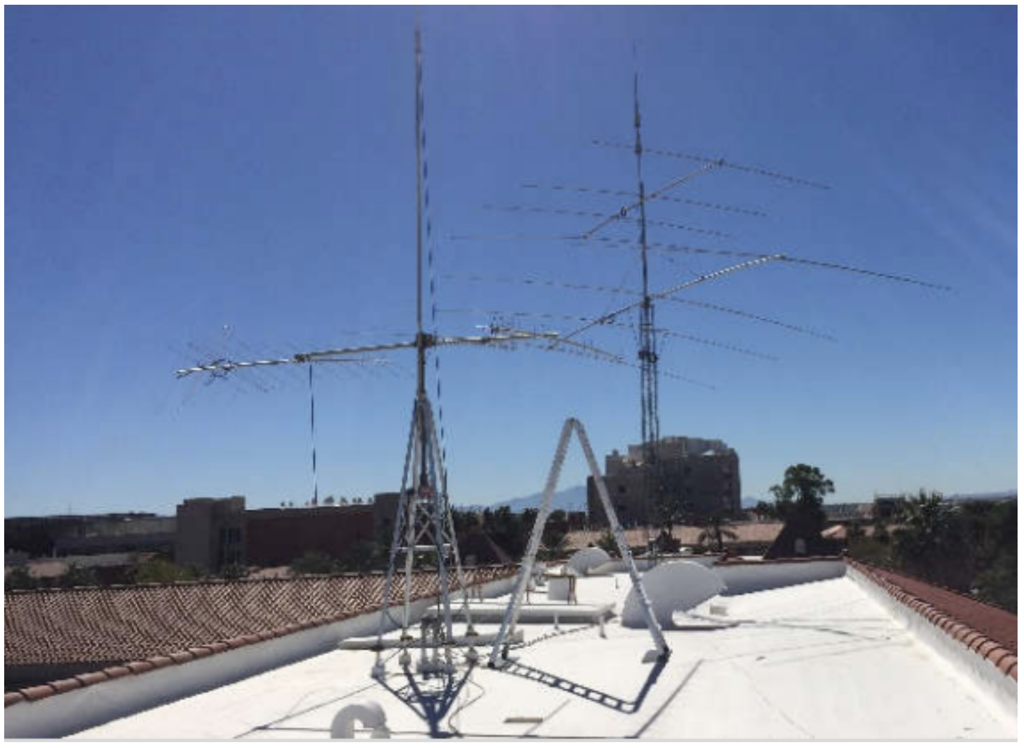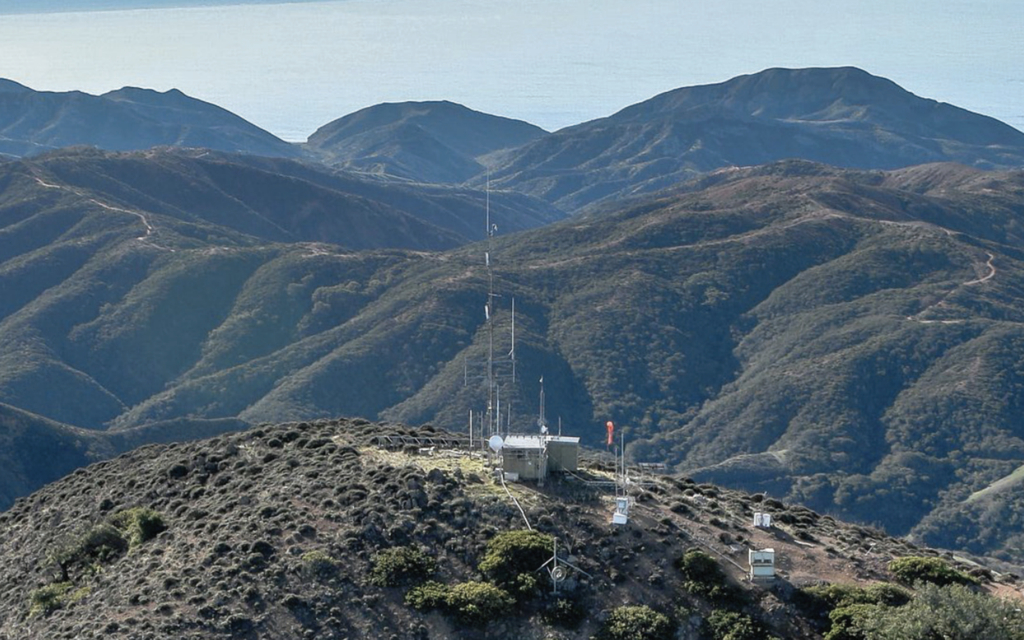ARDC Grants Support Amateur Radio Clubs
Key to ARDC’s mission is to support amateur radio, particularly the efforts of amateur radio clubs. So far, in 2021, we have awarded nearly a quarter million dollars to clubs around the U.S. for a variety of projects, including projects that expand and improve amateur radio infrastructure, demonstrate amateur radio’s unique capabilities, and teach new generations about amateur radio.
Grant allows Case Amateur Radio Club to replace towers
The Case Amateur Radio Club, the amateur radio club of Case Western Reserve University (CWRU) in Cleveland, Ohio, dates back to the 1940s. Today, the club enjoys a large and active student membership, plays a role in the engineering and English curriculum at CWRU, and supports NSF-funded research.
The key to their success is a combination of faculty support, integration with the curriculum, and research activity ranging from undergraduate projects through doctoral dissertations. For example, the club station, call sign W8EDU, is effectively a laboratory for radio frequency engineering classes and projects and gives students hands-on experience with directional antennas, support structures, and transmission lines.

To continue to serve the faculty and students, the club realized that it would have to replace their two rooftop towers and setup a maintenance schedule. The towers and antenna systems had been maintained informally by a cadre of club members, all long since retired. As a result, the antenna systems are now experiencing normal wear-and-tear failures, and the time is ripe to replace them with state-of-the-art equipment.
To enable the Case ARC to replace the aging towers and antennas, ARDC has awarded the club $81,763. The new towers will ensure that the club has high-quality HF capabilities and continue to attract new members and continued educational use. Additionally, the club expects the new towers and antennas to be used by the Ham Radio Science Citizen Investigation (HamSCI) Radiosport League, a working group that designs contests and other radiosport events to yield usable scientific data.
University of Arizona ARC reaches out to new students
The University of Arizona ARC hasn’t been around quite as long as the Case ARC, but they’re just as keen on reaching out to new students and improving its infrastructure. They requested $8,287 so that they could provide loaner radios to students. These radios allow the students to participate in the club’s weekly net, learn and practice digital modes, and become experienced in voice communications.
The club will also use the grant to improve the functionality, reliability, and safety of their club station, K7UAZ, by:
- Purchasing a new satellite transceiver,
- Replacing an aging FM transceiver and station computer,
- Replacing a 25 year-old antenna rotator, and
- Installing an effective lightning protection system, including PolyPhaser surge arresters, a lightning rod, ground wire, and multiple ground rods.
OH-KY-IN Amateur Radio Society improves internet connectivity, gears up for ARISS contacts
The OH-KY-IN Amateur Radio Society is one of the most active amateur radio clubs in the Cincinnati, Ohio, tri-state area. They operate multiple Yaesu System Fusion repeaters, including a repeater housed on the Channel 5 WLWT commercial television tower. This repeater hosts the daily Tri-State Amateur Traffic Net (part of the ARRL National Traffic System), and it is also used by Hamilton County ARES monthly net and the Amateur Radio Public Service Corps weekly net. They maintain two additional 2-meter repeaters, one housed atop a fire station to the west of Cincinnati and one on top of a hospital in Northern Kentucky.
Providing internet connectivity to the repeater sites is a real challenge. The terrain of the tri-state area and restrictions at the repeater sites make microwave links all but impossible. Instead, the club plans to set up cellular internet connections for the three repeater sites.
ARDC awarded the club $11,752 to purchase three computers, three commercial-grade cellular routers, two years of data service for those routers and two Yaesu WIRES-X HRI-200 interface boxes. This equipment allows them to accomplish three things:
- Enable experimentation with WIRES-X at the sites,
- Provide reliable remote computer access to allow the club to reprogram repeater controllers as needed, and
- Enhance their ability to remotely operate a software-defined radio (SDR) at the sites as needed to assist with interference troubleshooting.
The OH-KY-IN Amateur Radio Society was also awarded $5,288 for a portable satellite ground station that the club plans to use for:
- ARISS School Contacts at local and regional schools,
- Demonstrate satellite communications at ARRL Field Day and Winter Field Day,
- Demonstrate satellite communications as part of STEAM outreach at local and regional schools,
- Demonstrate satellite communications by decoding weather satellite data and experimental satellite telemetry, and
- Demonstrate Earth-Moon-Earth (EME) communications.
Rio Hondo Amateur Radio Club uses grant to get newcomers on the air
The Rio Hondo Amateur Radio Club (RHARC) got its start on the campus of Rio Hondo College in Whittier, CA, in 1976. RHARC is no longer associated with Rio Hondo Community College, but it carries on with the same sense of fellowship and purpose of action that the club had when it was formed. The club now operates three repeaters, one each on the 2 meter, 1.25 meter, and 70 cm bands. The repeaters operate under the club call W6KAT. The 2-meter and 70 cm repeaters are Yaesu System Fusion repeaters and operate in both analog and digital modes.
In May, ARDC awarded $4,454 to RHARC for three loaner radios to help get newly-licensed hams on the air. Before the newcomers are loaned the radios, they must show that they can change frequencies in the field, know how to adjust the squelch, can switch between FM and digital modes, and know how to pass traffic in a directed net. They are loaned the radios for six months and must show that they use the equipment regularly and participate in club events. In addition to purchasing loaner radios, the club plans to use the grant to replace their 1.25-meter repeater with a Bridgecomm BCR-220.
Santa Barbara ARC station is a window to unique coastal ecosystems
California’s coastal islands have a rich maritime history with strong ties to wireless communications dating back more than a century. Today, many of the islands are uninhabited and are either part of private land trusts, are part of the Channel Islands National Park, or are controlled by the U.S. military. Because the islands are so remote, they have unique flora and fauna, and as a result, have acquired the nickname “California’s Galapagos.”

To help them educate the public on these unique ecosystems, the Santa Cruz Island Foundation (SCIF) has invited the Santa Barbara Amateur Radio Club (SBARC) to build an amateur radio station at the new Chrisman California Islands Center (CCIC) in downtown Carpinteria, California. CCIC will be home to a museum-quality collection of artifacts from all of the islands off the coasts of California and Baja California, Mexico.
Using the volunteer-built amateur radio station, K6TZ, SBARC plans to offer visitors a glimpse of island life through island webcams, vessel, aircraft and wildlife tracking and other remote sensing technologies accessible over SBARC’s microwave data links and demonstrate amateur radio and wireless technologies in a modern and exciting way to visitors of all ages.
The station will be prominently featured on the gallery floor near the main entrance to bring the wonders of radio technology to the visiting public through an interactive display that includes a general overview of amateur radio communications. When the station is not staffed with radio operators, visitors to the center can interact with the station using a custom touch screen. This screen controls an interactive presentation on amateur radio and wireless technologies and their importance to mariners, aviators, scientists and explorers who visit the many rugged islands off the California coast. The presenation includes a demonstration of the station’s AIS (marine vessel), ADS-B (aircraft), emergency beacon (ELT/EPIRB), and amateur (APRS) tracking stations, and webcams and other data systems throughout the region riding on the Club’s microwave data backbone. The presentation will also show how club members and researchers use the information and data collected.
SBARC also plans to use K6TZ as a fully-functional club station for licensed SBARC members to operate analog and digital modes on HF, VHF, UHF, and microwave bands. Complete with a backup solar battery system and redundant fiber and point-to-point microwave internet connections, the station will be the nerve center for SBARC and SB Wireless. The Club also plans to host member events and allow SBARC members to operate the station for leisure and contesting. The station will also be available to Santa Barbara Amateur Radio Emergency Service (ARES) members for emergency communications purposes. Remote operating capabilities will permit members to access and operate the station from their homes, and video conferencing capabilities will allow members to speak with CCIC guests even when the station is not staffed.
ARDC grant helps build Oregon HamWAN backbone
Major earthquakes are always a possiblity in Oregon. When one occurs, internet, landline, and cell phone communications are likely to be disrupted. These disruptions effectively cut communication between volunteers, first responders, hospitals, and government agencies at a time when communications is most critical.
This is a situation in which amateur radio can play a vital role. Unfortunately, voice communication is slow, and traditional digital communication modes, such as Winlink, have limited bandwidth. To get around these limitations, [Oregon HamWAN](http://www.oregonhamwan.org) plans to set up portable HamWAN nodes in affected communities, allowing emergency management agencies to communicate effectively via high-speed email using HamWAN.
HamWAN technology supports high speed Internet connectivity (over 100 Mbps between backbone distribution sites, and up to 10 Mbps to each client node) over amateur radio using the 5.8 GHz band. Since HamWAN requires line of site communication, an effective HamWAN network requires deployment of HamWAN backbone distribution sites on towers. HamWAN supports a range of up to 50 miles between towers.
The value of HamWAN comes from the ability of amateur radio operators to set up mobile or portable HamWAN nodes, which can be aimed toward the nearest HamWAN Distribution Site to provide emergency communication via Internet during disasters. Such a mobile or portable setup requires HamWAN equipment costing less than $100, as well as an inexpensive WiFi router and a 12 V battery.
To set up this network, ARDC awarded Oregon HamWAN $88,391. With this money, Oregon HamWAN plans to deploy 12 HamWAN backbone distribution sites between Portland and Salem, Oregon to extend the Puget Sound Data Ring, which currently extends from Vancouver, Washington to Seattle. When complete, the network will extend from Vancouver, Washington to Salem, Oregon. The grant also includes funds for equipment used for education and demonstration purposes.
ARDC is committed to clubs – and is always accepting grant requests!
ARDC is committed to making things happen. If you have a big idea that you’d love to make happen, apply for a grant! Round 2 submissions for amateur radio clubs are due on August 1, 2021. We also review grant proposals on a rolling basis. Learn more at https://www.ardc.net/apply/. If you have questions or need help with your proposal, we’re here to help – reach out to giving@ardc.net. No inquiry is too small or too large.